East Bank
If you have limited time like I did, you can fit most of the East Bank attractions in one day. I spent the earlier part of the day at Luxor Temple, took the pleasant walk along to the Corniche to Karnak Temple a few kilometers away, and then returned to Alaa's to shower off the Luxor heat. In the evening, I walked along the Corniche again and admired the sunset over the mountains, visited the Luxor Museum, and went back to Luxor Temple at night to view it in lights.
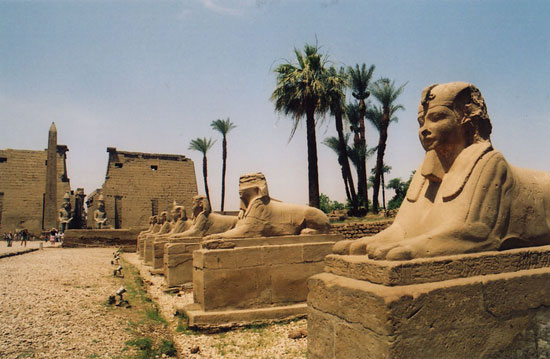 Luxor Temple is just a few minutes' walk from most hotels. The first sight of it along the Corniche was shocking to me: to my left was a busy city road packed with fancy cars and tour buses, and to my right were the elegant ruins of Luxor Temple dedicated to the Theban gods. It was such a fascinating mix of old and new, just like the sight of Cairo skyscrapers from the Giza Plateau. Egyptians live with their ghosts in a way I've never experienced.
Luxor Temple is just a few minutes' walk from most hotels. The first sight of it along the Corniche was shocking to me: to my left was a busy city road packed with fancy cars and tour buses, and to my right were the elegant ruins of Luxor Temple dedicated to the Theban gods. It was such a fascinating mix of old and new, just like the sight of Cairo skyscrapers from the Giza Plateau. Egyptians live with their ghosts in a way I've never experienced.
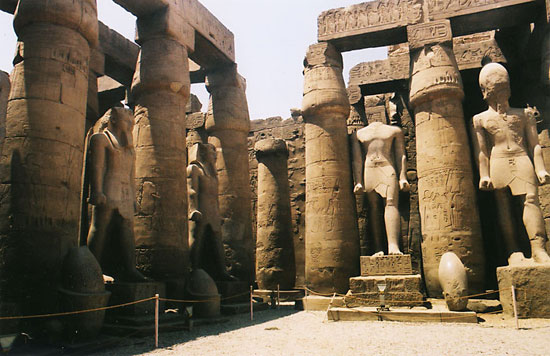 Stop at the ticket counter to pay the 20EP entrance fee, then walk away from the entrance to view the temple from the avenue of sphinxes. It's an impressive sight—this temple dedicated to Amun (one of the creation gods), Mut (mother goddess), and Khons (mood god) is in remarkable condition. Walk between the colossal statues of Ramses II to enter the main complex. You'll learn more about the temple from guidebook research than my journal, but suffice it to say, I was blown away by the beauty of the temple.
Stop at the ticket counter to pay the 20EP entrance fee, then walk away from the entrance to view the temple from the avenue of sphinxes. It's an impressive sight—this temple dedicated to Amun (one of the creation gods), Mut (mother goddess), and Khons (mood god) is in remarkable condition. Walk between the colossal statues of Ramses II to enter the main complex. You'll learn more about the temple from guidebook research than my journal, but suffice it to say, I was blown away by the beauty of the temple.
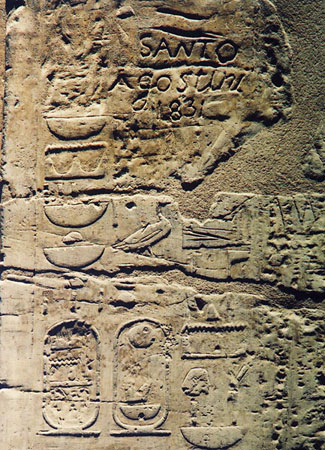 |
| Graf from the days before spraypaint |
Luxor is HOT, so there's really no need to walk to Karnak. It should cost about 3EP in a taxi, maybe 2EP if you really push it, and probably 2EP in a caleche. I chose to walk anyway and found the tree- and bench-lined Corniche really lovely. There was hassle from felucca touts and perfume salesmen along the way, but after a while, the avenue becomes much less commercial and you'll be walking alone. Just stay on the Corniche, pass the Luxor Museum, and eventually you'll see signs for Karnak.
Karnak is a massive structure featuring obelisks, statues, pylons, and sanctuaries glorifying the gods and pharaohs in a sprawling complex.
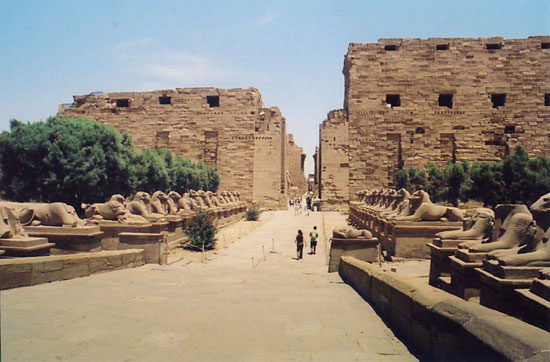
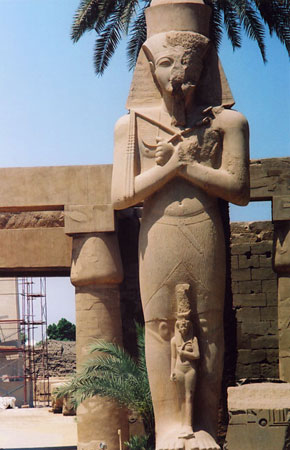 Again, you will get more background from doing your own research (despite my fantasies of coming to Egypt, I remain an idiot about the intricacies and significance of it all), and all I can tell you is that Karnak is a must-see. There are great views of the whole complex from Mut Temple, a lovely sacred lake, and the Great Hypostyle Hall can make anyone feel miniscule.
Again, you will get more background from doing your own research (despite my fantasies of coming to Egypt, I remain an idiot about the intricacies and significance of it all), and all I can tell you is that Karnak is a must-see. There are great views of the whole complex from Mut Temple, a lovely sacred lake, and the Great Hypostyle Hall can make anyone feel miniscule.
Once again, it is difficult to escape the demands for baksheesh here. At the Mut Temple, the guards snuck me up to the roof despite the signs prohibiting it and then requested payment for allowing me up, when I had never asked to climb up. Karnak costs 20EP to enter and is graced with its own avenue of sphinxes, which each feature a ram's head and a small statue of Ramses II between its paws.
It was low season in Egypt, and in general, I didn't see too many tourists. However, both Luxor and Karnak temples are tour bus havens, so expect hordes. But Karnak's sheer size means you will easily be able to find yourself alone—there are just too many nooks and crannies and the tour groups move slowly. It was a nice place to contemplate the hieroglyphics, stare at obelisks, and wander through the shadows without constantly being jostled by other tourists. I spent a couple hours at each temple.
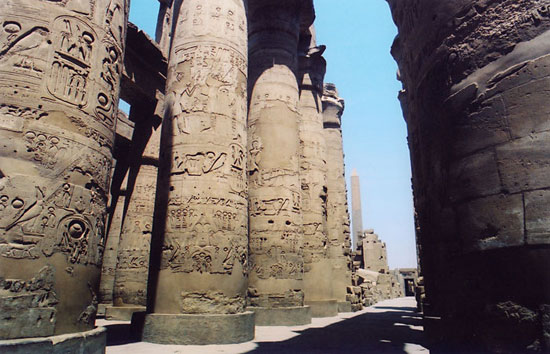 |
| Massive columns at Karnak Temple |
Ah, the joys of air-conditioning. If you need a place to escape the afternoon heat, Luxor Museum is your place! And hey, it's an amazing museum as a bonus, worth at least 2 hours.
I believe the entrance was 15EP with my student ID. There are signs everywhere prohibiting the use of cameras, a rule blatantly violated inside. Guards don't seem to care. When you first enter, you can view a short film about some of the museum's treasures, including the two mummies from excavation to arrival in Luxor.
Most of these items were once inside the temples I visited during the day: beautiful jewelry, pottery, and stelaes. The mummies were in excellent condition. My favorite display was the tomb designers' plans etched onto rock, a fascinating look at the architectural details of these ancient structures. There may be an order for viewing the displays, as guards kept pointing me in certain directions. Baksheesh did not seem to be an issue here.
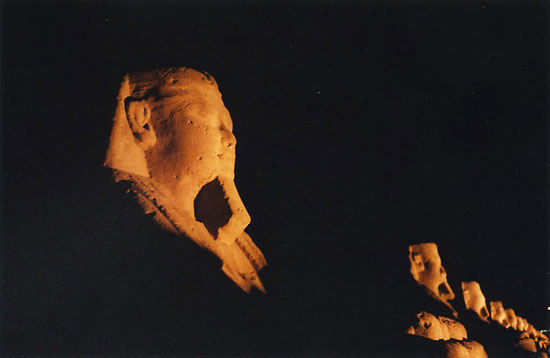
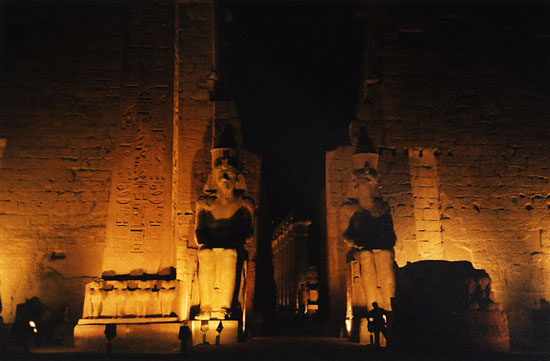 I revisited Luxor Temple to view it by night. One of the most elegant displays in Egypt, the temple is simply lit without a narrated show. It's a beautiful, different view of an already lovely temple and well worth the second trip. The columns in the Great Court look like they're on fire, the sphinxes are eerie, and the view from the Corniche with the moon hovering above is just striking. There are not many tourists, so the atmosphere is much more peaceful.
I revisited Luxor Temple to view it by night. One of the most elegant displays in Egypt, the temple is simply lit without a narrated show. It's a beautiful, different view of an already lovely temple and well worth the second trip. The columns in the Great Court look like they're on fire, the sphinxes are eerie, and the view from the Corniche with the moon hovering above is just striking. There are not many tourists, so the atmosphere is much more peaceful.
After the temple, I had a late dinner at the Metropolitan Bakery-Café on the Corniche. The view was lovely, but the food was no good, and it was definitely a tourist-only spot. Guava juice was good but incredibly overpriced compared to juice shops in Cairo. Still, it was a pleasant way to finish the evening.
I'll just close out this entry about the East Bank with the tip that if you need a free bathroom, the one in Mahroba restaurant near Aboudi Bookshop (south of the Luxor Temple) is very nice and they don't mind if you aren't a customer. Aboudi Bookshop also has Internet access at the typical rate of 5EP/hour.